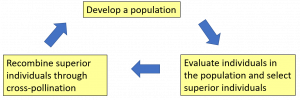Chapter 6 – Plant Breeding
Plant breeding has been defined as “the art and science of improving the heredity of plants for the benefit of humankind” (Sleper and Poehlman, 2006). Two aspects of this definition are worth emphasizing: (1) the discipline is a combination of creative, subjective thinking (the art) and objective, technology-driven activity (the science); and (2) plant breeding programs are directed toward societal benefit. Indeed, many of the world’s most pressing problems can be addressed, at least partially, through plant breeding. Producing an adequate supply of nutritious food; reducing agriculture’s impact on the environment; and adapting to (or mitigating) the effects of climate change are all areas where plant breeding has an important role to play.
This section of the field tour focuses on three concepts that have been important in plant breeding: the use of landrace germplasm in crop improvement; hybrid vigor or heterosis; and recurrent selection.
Landraces are traditional varieties grown by farmers, usually in areas of subsistence agriculture. They are often lower yielding than modern cultivars, but are well adapted to local environmental conditions and food preferences. Landraces possess tremendous amounts of genetic variation and therefore have been conserved in genebanks and in in situ reserves. Mexico and the U.S. Southwest have a rich heritage of corn landraces, a few of which are shown in the accompanying video.
Hybrid vigor (heterosis) is the improved performance of a hybrid (the offspring of cross-pollination between different varieties) relative to its parents. As shown in the videos, two crops in which hybrid cultivars predominate in the U.S. are corn and sunflower. In addition to improved yield, hybrid cultivars have better uniformity in their growth and development, which can benefit crop management, for example by having all plants in a field mature at the same time. Not all species show the same level of heterosis. Whereas corn hybrids may more than double the yield of their parents, wheat hybrids often show just 20% or less yield improvement.
Recurrent selection is a method for gradually increasing the frequency of favorable alleles (alternative forms of a gene) for a quantitative trait like maturity or yield, while retaining genetic variation for the trait. It is conducted through repeated cycles of selection, as shown in this diagram.

The recombined fraction becomes the starting population for the next cycle of selection and the process repeats for several cycles. There are many variations to the basic method, for example in the percentage of individuals selected each cycle (typically 10 to 20%), the intensity with which individuals are evaluated, and whether a generation of self-pollination occurs before recombination. In the video you’ll see the gradual reduction of plant height and maturity of a tropical corn population selected for adaptation to Iowa in the U.S. Corn Belt.
videos
In this collage of images, click on the video play button to view a short video that demonstrates the effects of different plant breeding strategies. The video will open in the full image and you can click play to start it. Once you are finished, click on the “X” in the upper right corner to bring you back to the image collage. If you wish to expand the video to fill your entire screen, clicking “Watch On YouTube” will open a new browser window to give you that option. All videos have closed captioning. (Photo credits: Corn Landraces and Sunflower Hybrids: Gayle Volk, USDA; Corn Hybrids and Corn Recurrent Selection: Pat Byrne, Colorado State University.)
review
Click through these interactive questions to review the important concepts that were discussed in this chapter.
